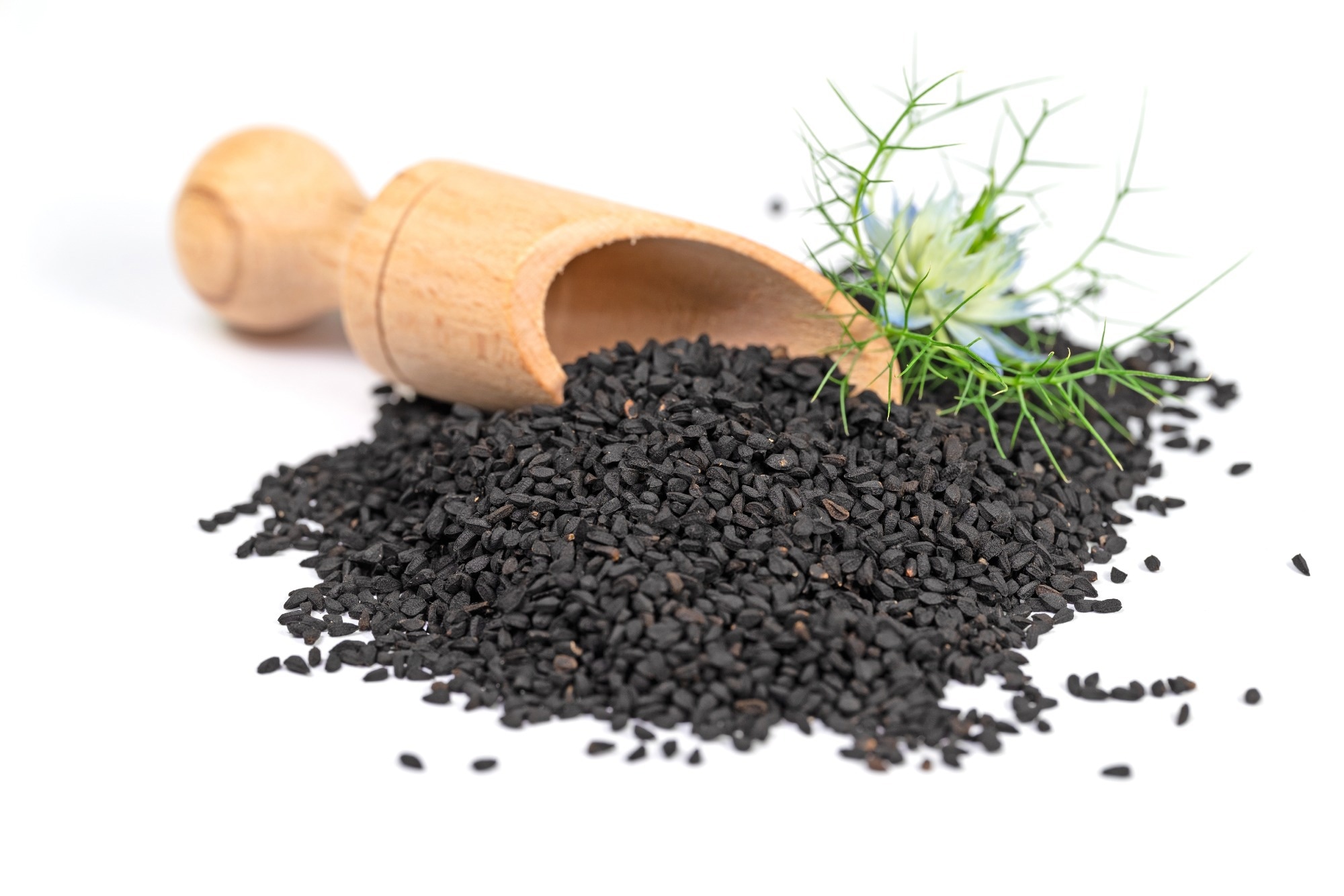In a recent review published in the journal Biomedicines, researchers discuss the potential of Nigella sativa as a pharmaceutical agent.
 Study: The Use of Nigella sativa in Cardiometabolic Diseases. Image Credit: M. Schuppich / Shutterstock.com
Study: The Use of Nigella sativa in Cardiometabolic Diseases. Image Credit: M. Schuppich / Shutterstock.com
Nigella sativa: Distribution and phytoconstituents
Nigella sativa, which is commonly known as black seeds or black cumin, belongs to the Ranunculaceae family. The fruit of the Nigella sativa plant contains three to six carpels, each of which contains seeds that turn black when mature.
India is the largest producer of Nigella sativa, whereas Brazil, Colombia, Malaysia, and Canada are among the main exporters. In addition to India, Nigella sativa is also grown in Egypt, Greece, Saudi Arabia, Iran, and Pakistan.
The main bioactive components of Nigella sativa are derived from its seeds, followed by its bark and sprouts. Several primary and secondary metabolites of different chemical classes, such as alkaloids, terpenes and terpenoids, phytosterols, flavonoids, phenolic acids, and tannins, have been identified within Nigella sativa.
Nigellamines, which are the main alkaloids, and polyphenols, such as quercitrin and kaempferol, have been identified in Nigella sativa. Several fatty acids, including oleic, linoleic, and palmitic acids, have also been isolated from black cumin.
The pharmacological properties of Nigella sativa have been attributed to the presence of quinine components, particularly thymoquinone (TQ) and its derivatives, including 4‐terpineol, thymohydroquinone (THQ), p‐cymene, sesquiterpene, thymol, carvacrol, and t‐ anethol.
Medicinal use of black cumin
Black cumin has been used in traditional Chinese medicine, Arabian medicine, and Ayurveda. In Arabian medicine, Nigella sativa has been used for the treatment of asthma, bronchitis, diarrhea, indigestion, dysmenorrhea, amenorrhea, and skin infections. Comparatively, in Chinese medicine, Nigella sativa has been used as a component of formulation for the treatment of headaches.
The oil extracted from Nigella sativa seeds has antioxidant, anti‐inflammatory, immunomodulatory, and antibacterial properties. Black cumin contains tocopherols that have robust antioxidant effects, which inhibit lipid peroxidation in biological membranes.
Black cumin has been considered a natural agent that can reduce blood cholesterol. Additionally, the high levels of sterols in Nigella sativa suggest its potential use in preventing cardiovascular diseases (CVDs). Nigella sativa is also effective against diabetes, inflammatory conditions, and menopause.
Key mechanisms of Nigella sativa in alleviating cardiometabolic diseases
Several mechanisms may contribute to the protective cardiometabolic role of Nigella sativa. For example, the antioxidant properties of Nigella sativa may reduce blood pressure in patients with hypertension, whereas the anti-radical scavenging activity of TQ significantly reduces reactive oxygen species (ROS) levels.
Nigella sativa seed extracts exhibit increased catalase, superoxide dismutase, and glutathione reductase activities, which causes a significant reduction in malondialdehyde (MDA). Several studies have shown that MDA is an indicator of lipid peroxidation derived from oxidative stress. Reduced ROS levels also increase the bioavailability of nitric oxide (NO), which can significantly reduce blood pressure.
Many cardiometabolic diseases are associated with inflammation; therefore, a reduction in inflammation should have a positive effect on these diseases. Nigella sativa has been shown to inhibit inducible NO synthase, as well as reduce cytokine and pro‐inflammatory cytokine levels through inhibition of the nuclear factor κB (NF‐κB) signaling pathway. Nigella sativa has the potential to inhibit cyclooxygenase 2 (COX-2), which is an enzyme-linked with the production of inflammatory mediators, such as prostaglandins (PG).
Nigella sativa seed extracts also exhibit anti‐dyslipidemic properties. To this end, black cumin seed extract inhibits the expression of 3-hydroxy-3-methylglutaryl coenzyme A (HMG-CoA) reductase and increases the expression of low-density lipid receptors, both of which are associated with reduced cholesterol levels.
TQ acts as a peroxisome proliferator-activated receptor gamma (PPAR-γ) antagonist, which can improve insulin resistance and inhibit intestinal α‐ glucosidase, the latter of which leads to reduced glucose absorption. TQ also improves the proliferation and integrity β pancreatic cells, thereby resulting in elevated insulin secretion.
The weight reduction effect of Nigella sativa has been reported in many studies. Mechanistically, Nigella sativa induces a reduction in food intake, inhibition of intestinal glucose absorption, and increased adiponectin levels.
The cardioprotective effects of Nigella sativa seeds were demonstrated using isoproterenol‐induced myocardial injury in rats. Black cumin's cardioprotective activity has also been associated with the mitigation of inflammation and oxidative stress.
Conclusions
Nigella sativa seeds have been used for multiple disease treatment strategies. Among the various bioactive metabolites present in black cumin, TQ is associated with most of its pharmacological properties.
Journal reference:
- Derosa, G., D’Angelo, A., Maffioli, P., et al. (2024) The Use of Nigella sativa in Cardiometabolic Diseases. Biomedicines 12(2);405. doi:10.3390/biomedicines12020405